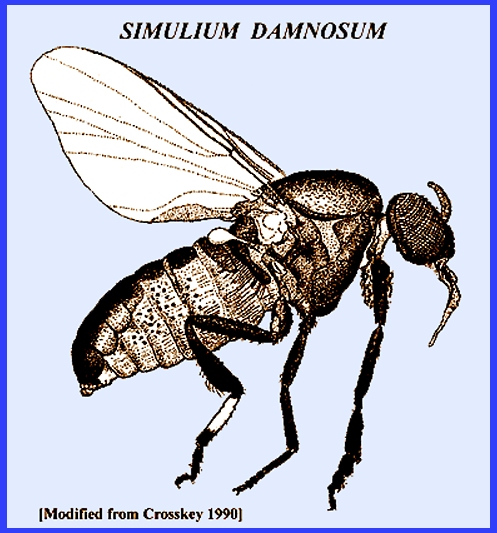File: <simuliidaekey.htm> <Medical
Index> <General Index> Site Description Glossary <Navigate to Home>
|
Arthropoda: Insecta SIMULIIDAE KEY TO GENERA (Black flies) (Contact) Please CLICK on underlined links
to view images or to navigate within the key: Search
for Subjects with Ctrl/F [See: Simuliidae
Details]
The genus Simulium continues to be the most important genus by virtue
of having many species that are vectors of disease such as onchocerciasis
especially in tropical regions. (Also
see Simuliidae Details). The
following key, using a system devised by Smart (1946) separates six important
genera:
_ _ _ _ _ _
_ _ _ _ _ _ _ _ _ _ _ _ _ _ Key References: <medvet.ref.htm> <Hexapoda> Adler, P. H., D. C.
Currie & D. M. Wood. 2004. The Black Flies (Simuliidae) of North
America. Comstock Publ. NY &
London. Blacklock, D. B. 1926.
The development of Onchocerca
volvulus in Simulium damnosum. Ann. Trop. Med. Parasit. 20: 1-48, 203-18. Daley,
Beth. 2008. Black flies surge in
Maine's clean rivers. Boston Globe Boatin, B. A. & F.
O. Richards. 2006. Control of onchocerciasis. Adv. in Parasitol. 61: 349-54. Borradaile, L. A. &
F. A. Potts. 1958. The
Invertebrata: A Manual For The Use Of Students. Cambridge Univ. Press, Bentley Hs, London.
795 p. Crosskey, R. W. 1990.
The Natural History of Blackflies.
Wiley Publ., Chichester, England. De Villiers, P. C. 1987.
Simulium dermatitis in
man: clinical and biological features in South Africa. So. Afr. Med. J. 71: 523-25. Hough,
Andrew. 2010. Blandford
fly: surge in infected insect bites blamed on new superfly. The Daily
Telegraph. London. Matheson, R. 1950. Medical Entomology. Comstock Publ. Co, Inc. 610 p. Molyneux, D. H. 2005.
Onchocerciasis control and elimination: coming of age in resource-constrained health systems. Trends in Parasitol 21:
525-29. Service, M. W. 1977.
Methods for sampling adult Simuliidae, with special reference to the Simulium damnosum complex. Trop. Pest Bull. 5: 1-48. Service, M. 2008.
Medical Entomology For Students.
Cambridge Univ. Press. 289 p
(See pp. 81-92). Smart, J. 1945.
The classification of the Simuliidae (Diptera). Trans. Roy Ent. Sos., London 95: 463-532. Legner, E. F. 1995. Biological control of Diptera of medical and veterinary
importance. J. Vector Ecology 20(1):
59-120. Legner, E. F. 2000.
Biological control of aquatic Diptera. p. 847-870.
Contributions to a Manual of Palaearctic Diptera, Vol. 1, Science Herald, Budapest. 978 p. Thompson, F. C. 2001.
The Name of the Type Species of Simulium
(Diptera: Simuliidae): Ent. News
112(2): 125. |
